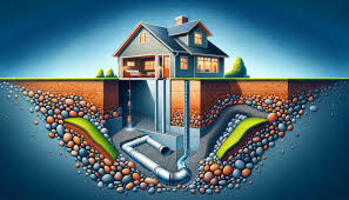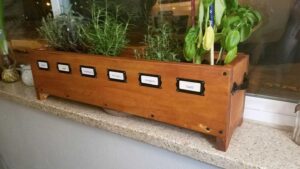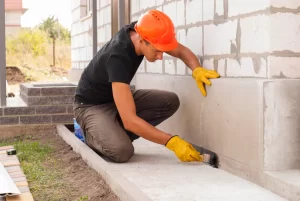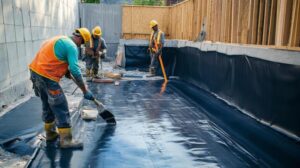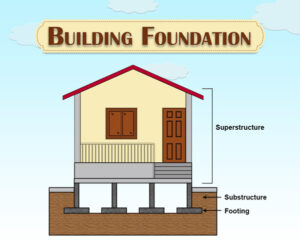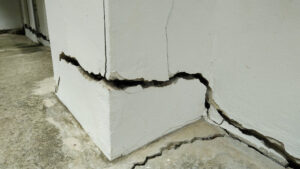Table of Contents
ToggleWhat is French Drain Basement Waterproofing
French drain basement waterproofing involves installing a drainage system that collects and directs water away from your home’s foundation. It consists of perforated pipes buried in a trench filled with gravel or stone, which helps guide groundwater or surface water toward an outlet, like a sump pump or drainage area.
By controlling water flow around your basement, French drains prevent moisture buildup, flooding, and structural damage, keeping basements dry and mold-free.

The Importance of French Drain Basement Waterproofing
Basement flooding can lead to costly repairs, mold growth, and foundation damage. French drains play a crucial role by diverting water away from your basement before it becomes a problem. In areas with high water tables or homes with improper grading, French drains offer the best defense against moisture intrusion. Proper waterproofing ensures a healthy, dry living space and protects your property’s long-term value.
Read More: Top 10 Tips For Waterproofing Basement Walls From Inside
Where are French Drains for Basement Waterproofing Installed?
Interior French Drain:
Interior French drains are installed along the perimeter of the basement floor, just inside the foundation walls. A trench is cut into the concrete floor, and perforated pipes are laid to collect water that seeps through the walls. The collected water is then directed to a sump pump, which removes it from the basement. Interior drains are ideal for basements that frequently flood or have hydrostatic pressure issues.
Exterior French Drain:
Exterior French drains are installed around the outside perimeter of the home, near the foundation. They are placed below the ground level to intercept water before it reaches the basement walls. Gravel surrounds the perforated pipes, which direct water to a drainage point away from the house. While more labor-intensive to install, exterior drains provide excellent protection from water intrusion.
How Do French Drains Work?
The Trench:
The trench is dug along the foundation wall (inside or outside) and filled with gravel to aid water flow. This trench creates a path of least resistance for water.
The Pipe:
A perforated pipe is placed at the bottom of the trench to collect water. The holes allow groundwater to seep in and travel through the pipe toward the outlet.
The Pitch:
The pipe must be installed at a slight downward angle, or pitch, to ensure water flows efficiently toward the drainage point. A proper slope ensures that water won’t stagnate inside the pipe.
The Outlet:
The collected water is carried to an outlet, such as a sump pump or storm drain. If connected to a sump pump, the water is expelled away from the house to prevent it from re-entering the foundation area.
How Much Does It Cost to Install a French Drain in a Basement?
The cost of installing a French drain in a basement varies depending on factors like location, labor rates, and the type of system (interior or exterior). On average, interior French drains cost between $3,000 and $7,000, while exterior drains can range from $5,000 to $15,000 due to the added excavation work. DIY installations can reduce costs, but professional installation ensures proper drainage and reduces the risk of errors.
What’s the Difference Between a Basement Floor Drain and a Basement French Drain?
A basement floor drain is a simple drainage solution that collects water at a single point, usually connected to a sump pump or sewer system. In contrast, a French drain is a perimeter drainage system designed to capture water along the entire foundation, preventing water from entering the basement. While floor drains handle surface water, French drains address groundwater and hydrostatic pressure issues, providing more comprehensive waterproofing.
How Do You Know if You Need a French Drain for Basement Waterproofing?
Signs that indicate you might need a French drain include:
- Frequent basement flooding after heavy rain
- Damp or wet basement walls and floors
- Visible mold or mildew in the basement
- Water pooling near the foundation
- Cracks in the foundation walls due to hydrostatic pressure
If your basement consistently has water issues, a French drain can provide the necessary protection to prevent further damage.

Best Case Uses of French Drains:
- Homes with high water tables or poor drainage around the foundation
- Properties with improper grading that directs water toward the home
- Basements that experience frequent flooding or moisture problems
- Preventing hydrostatic pressure buildup along the foundation walls
French Drain Limitations:
While French drains are highly effective, they do have some limitations:
- Installation Cost: Exterior drains are expensive and labor-intensive to install.
- Maintenance: Clogs can occur over time, requiring occasional cleaning.
- Landscaping Disruption: Exterior drains require digging, which may disturb your landscaping.
- Not a Complete Solution: French drains may need to be paired with other waterproofing methods, like sump pumps, for optimal results.
French drain basement waterproofing is a reliable solution for managing water intrusion and protecting your home’s foundation. Whether you opt for an interior or exterior system, a properly installed French drain ensures your basement stays dry and safe from flooding. If you’re experiencing basement water issues, contact Capital Deck and Stair Waterproofing to determine the best waterproofing solution for your home.

